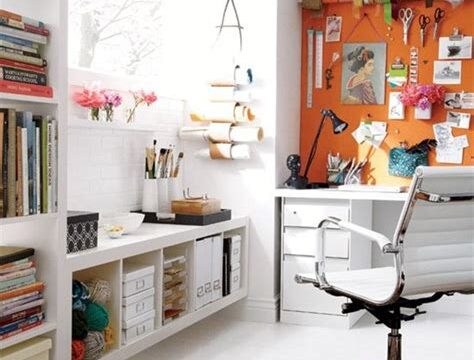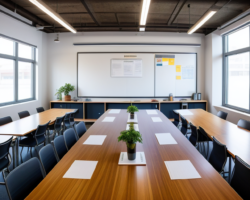Are you considering transforming that spare room in your home into a fully functional workshop? Whether you are a DIY enthusiast or a professional craftsman, having a dedicated space for your projects can make a significant difference in productivity and creativity. In this blog post, we’ll explore the essential steps to turning a spare room into a practical and efficient workshop. From assessing the space and layout to organizing tools and equipment, setting up workbenches and storage, creating a proper lighting system, ensuring adequate ventilation and safety, adding workstation ergonomics, and designing an inspiring and motivating atmosphere, we’ll cover everything you need to know to make the most of your workshop space. So, if you’re ready to elevate your crafting and DIY game, let’s dive into the exciting world of turning a spare room into the workshop of your dreams.
Assessing the Space and Layout
When assessing the space and layout of your workshop, it’s important to consider the overall organization and flow of the area. Take into account the size of the space and how it can best be utilized for your specific needs. Whether you’re setting up a woodworking shop, a crafting space, or a garage workshop, it’s essential to carefully evaluate the available space and how it can be optimized for efficiency and functionality.
Consider factors such as the location and size of doors and windows, as well as any obstacles or potential hazards that may need to be addressed. Additionally, think about how the layout will affect the access to tools, equipment, and workbenches, and how it may impact the overall workflow of your projects.
By carefully assessing the space and layout of your workshop, you can create a well-organized and efficient environment that enhances your productivity and creativity.
Remember, the goal is to design a space that not only meets your current needs but also allows for flexibility and adaptability as your projects and interests evolve.
Organizing Tools and Equipment
When it comes to organizing tools and equipment in your workspace, it’s important to have a systematic approach that will help improve efficiency and productivity. One of the first steps in organizing your tools and equipment is to declutter and sort through them. This means getting rid of tools that are no longer used or in poor condition, and keeping only the ones that are essential for your work.
Once you have sorted through your tools, it’s important to establish a dedicated storage space for each type of equipment. This will not only make it easier to find the tools you need, but also help prevent clutter and disorganization in your workspace. Consider using tool cabinets, pegboards, or shelving units to store and organize your tools in a way that is easily accessible.
In addition to physical storage solutions, it’s also helpful to label and categorize your tools and equipment. This will further streamline the organization process and make it easier to find specific items when you need them. Whether you use color-coded labels, tool outlines, or simply clear and descriptive labeling, having a system in place will prevent tools from getting misplaced and help maintain an organized workspace.
Lastly, it’s important to establish a routine for maintaining the organization of your tools and equipment. This may involve regular cleaning, sorting, and reorganizing to ensure that everything remains in its proper place. By taking the time to establish and maintain an organized system for your tools and equipment, you can create a workspace that is not only efficient, but also a pleasant and inspiring environment to work in.
Setting Up Workbenches and Storage
Setting up the workbenches and storage in your workshop is a crucial part of creating an efficient and organized space for your projects. Workbenches are essential for providing a sturdy and stable surface for working on various tasks, whether it’s woodworking, metalworking, or crafting. It’s important to choose a workbench that suits your specific needs, such as one with a durable top surface and plenty of storage options.
When it comes to storage, having a designated area for your tools and equipment is key to maintaining a clean and functional workspace. Consider installing shelves, cabinets, and pegboards to keep everything organized and easily accessible. You may also want to invest in tool chests or tool cabinets to keep your tools secure and well-organized.
Additionally, think about the layout of your workbenches and storage in relation to the rest of your workshop. It’s important to have a clear flow and designated areas for different types of tasks. This can help you maximize efficiency and minimize clutter in your workspace.
By carefully setting up your workbenches and storage, you can create a workspace that is not only organized and efficient, but also conducive to creativity and productivity. When everything has its place and is easily accessible, you can focus more on your projects and less on searching for tools and supplies.
Creating a Proper Lighting System
When setting up a workshop, one of the most essential aspects to consider is lighting. In order to create a productive and safe working environment, it is crucial to ensure that the space is well-lit. Proper lighting is not only important for visibility, but it also plays a significant role in reducing eye strain and fatigue, ultimately leading to enhanced productivity.
There are several factors to consider when creating a proper lighting system for your workshop. Firstly, it’s important to assess the natural light sources in the area. If possible, maximize the use of natural light by positioning workstations close to windows or skylights. This can help to reduce the dependency on artificial lighting during the day.
Additionally, when it comes to artificial lighting, it’s important to choose the right type of light fixtures for the space. LED lights are a popular choice for workshops due to their energy efficiency and bright, clear illumination. Consider installing overhead LED panel lights or adjustable task lights to ensure that different areas of the workshop are well-lit according to specific needs.
Furthermore, it’s important to avoid glare and shadows in the workshop. Position light fixtures in a way that minimizes glare on work surfaces and machinery, and make sure that there are no dark spots or shadows in the workspace that could pose safety risks. By strategically placing lighting fixtures, you can ensure an even distribution of light throughout the workshop.
Ensuring Adequate Ventilation and Safety
When setting up a workshop, it is crucial to prioritize ventilation and safety to create a healthy and secure environment for working. Adequate ventilation helps to maintain air quality by preventing the buildup of harmful fumes and dust particles. This can be achieved by installing exhaust fans, air purifiers, and keeping windows open for natural airflow.
Additionally, it’s important to have safety measures in place to prevent accidents and injuries. This includes proper storage of hazardous materials, clearly marked emergency exits, and regular maintenance of equipment to ensure they are in good working condition.
Investing in quality respirators, gloves, and safety goggles can also provide added protection for individuals working in the workshop. By implementing these measures, the workshop can be a safe and healthy space for creativity and productivity.
Remember, the well-being of those working in the workshop should always be the top priority, and taking the necessary steps to ensure adequate ventilation and safety will contribute to a positive and productive work environment.
Adding Workstation Ergonomics
When setting up your workspace, it’s important to consider the ergonomics of your workstations. Ergonomics is the science of designing the workspace to fit the worker, rather than forcing the worker to fit the workspace. Proper ergonomics can help prevent musculoskeletal disorders, improve productivity, and increase overall comfort and satisfaction in the workplace.
One way to add workstation ergonomics is by ensuring that the height of the desk and chairs are adjustable, allowing for proper alignment of the body to reduce strain on the back, neck, and shoulders. It’s also important to have adequate lumbar support in chairs to promote good posture. In addition, using a keyboard and mouse with proper wrist support can help prevent repetitive strain injuries.
Another important aspect of workstation ergonomics is positioning computer monitors at eye level to reduce strain on the eyes and neck. Proper lighting and glare reduction are also important factors to consider. It’s essential to create an environment that minimizes physical discomfort and fatigue, allowing employees to focus on their work without distraction or physical strain.
By prioritizing workstation ergonomics, you can create a healthy and productive work environment that supports the well-being of your employees and contributes to the overall success of your business.
Designing a Inspiring and Motivating Atmosphere
When it comes to creating a workspace that promotes creativity and productivity, designing an inspiring and motivating atmosphere is crucial. The environment in which we work can have a significant impact on our mood, energy levels, and overall well-being. By incorporating elements that inspire and motivate, we can create a space that fosters innovation and enthusiasm.
One important aspect of designing an inspiring and motivating atmosphere is to incorporate elements that reflect your personal style and interests. Whether it’s incorporating artwork, plants, or personal mementos, surrounding yourself with things that bring you joy can help create a positive and uplifting environment.
Another key factor in designing an inspiring and motivating atmosphere is to create a space that is well-organized and clutter-free. A tidy and organized workspace can help alleviate stress and make it easier to focus on the task at hand. Utilizing storage solutions, such as shelves, bins, and organizational systems, can help keep the space neat and tidy.
In addition to creating a visually appealing environment, it’s important to consider the use of color and lighting in the workspace. Colors have been shown to have a significant impact on mood and productivity, so incorporating hues that are uplifting and energizing can help set the tone for the space. Furthermore, ensuring adequate natural light and incorporating task lighting can help create a bright and inviting atmosphere.





